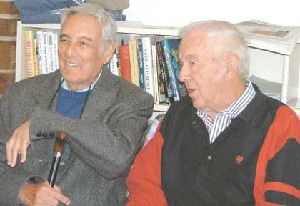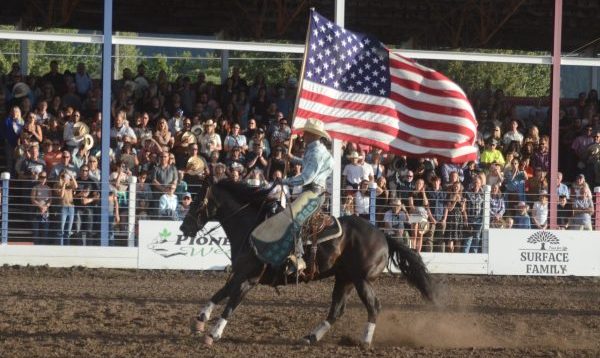Discover Wallowa County 2024: Tomes take a deep dive into county
Published 7:00 am Wednesday, April 3, 2024

- Alvin Josephy Jr., left, enjoys a conversation with friend Jack McClaran at his 90th birthday party in Enterprise in the summer of 2005. Josephy is the namesake for the Josephy Center for Arts and Culture in Joseph. Rich Wandschneider of the Josephy Center will begin a four-week series of coffee conversations about Josephy and the Nez Perce beginning Friday, June 14 at the center.
If you can’t get to Wallowa County, the next best thing might be reading about it.
And if you can get to Wallowa County, bringing along a book about the area guarantees a deeper and richer experience.
Trending
It’s no secret anymore: Wallowa County is one of Oregon’s hotspots for terrific writing. The county has inspired any number of great books, all of which would be excellent companions on your next trip — even if it’s a trip from the comfort of your reading chair.
We consulted a variety of experts in compiling what is, by necessity, an incomplete list of essential books about Wallowa County. Our experts come from an Enterprise bookstore, a Joseph museum and an Enterprise nonprofit organization devoted to good writing about the West. All three are spots that book lovers will want to check out during a visit to the county:
• The Bookloft, 107 E. Main St., a beautifully curated bookstore in downtown Enterprise. The store’s website, bookloft.org, features a much lengthier list of books about Wallowa County.
• Fishtrap, 107 W. Main St. in Enterprise, offers readings from local writers and also hosts an annual summer workshop, Summer Fishtrap, on the shores of Wallowa Lake that attracts nationally known writers to lead workshops during the day and read from their works during the evenings. (The 2024 edition of Summer Fishtrap will be held July 8-14.) Find out more at fishtrap.org.
• The Josephy Center for Arts and Culture, 403 N. Main St. in Joseph, offers artwork from local artists in a series of imaginative exhibits and hosts classes, concerts, lectures and more. It also houses the Josephy Library of Western History and Culture, which is run by Rich Wandschneider, a longtime county resident and a fine writer himself. Find out more about the Josephy Center at its website, josephy.org. The center is open from noon to 4 p.m. Mondays through Saturdays.
Here are some of the books that our experts recommended. Happy reading:
Trending
• “Temperance Creek,” by Pamela Royes. Royes beautifully recounts her story of coming to Wallowa County and falling in love with a man and the place together. It’s a great portrait of riding the canyonlands, and a requiem of sorts for a specific moment in the 1970s.
• “Home Below Hells Canyon,” by Grace Jordan. This memoir, set in the 1930s, follows the Jordan family (Les, his wife Grace and their three small children) as they move — in the heart of the Great Depression to a sheep ranch in the Snake River gorge just below Hells Canyon.
• “Massacred for Gold,” by Gregory Nokes. A glimpse into our darker history, this book tells the story of the murder of 34 Chinese gold miners in 1887 in Hells Canyon and helps put into perspective the brutality and racism of early pioneer life.
• “Winterkill,” by Craig Lesley. Danny Kachiah, the protagonist of Lesley’s novel, is an aging rodeo rider, a Nez Perce who has never connected with his tribal culture. But when his ex-wife dies in a car accident, leaving him a son whom he barely knows, he begins to recall the stories that his father, Red Shirt, had told him. Lesley returns to Kachiah’s story in a follow-up novel, “River Song.”
• “Chief Joseph and the Flight of the Nez Perce,” by Kent Nerburn. An engaging biography of Chief Joseph and the Wallowa Band of the Nez Perce, who were chased from Wallowa County in 1877.
• “Stories of Wallowa Lake,” by Rita Ehrler and Ellen Morris Bishop. A well-researched and well-written collection of stories and photos that build a picture of the people, places and nature that make up the communities of Wallowa Lake.
• “Nez Perce Country,” by Alvin Josephy. Many books focus on the War of 1877 when it comes to Nez Perce history. This book offers a concise introduction to the greater history of the Nez Perce people. Josephy, by the way, was an American historian who specialized in Native American issues; he and his wife, Betty, owned a ranch in Joseph and hosted a camp for Nez Perce children. The Josephy Center was founded in his name. If you want a deeper dive into Nez Perce history, consider an earlier Josephy book, “The Nez Perce Indians and the Opening of the Northwest.”
• “Four Lines a Day,” by Janie Tippett. Every day for 60 years, Mary Marks wrote four lines in her journal. Her friend, Janie Tippett, took this collection to create a wonderful picture of the tough and rewarding job of ranching in the wilds of the Imnaha country.
• “The Prairie Keepers,” by Marcy Houle. Houle came to the Zumwalt Prairie in 1979 to study hawks. Based on that time, she has written an engaging personal story of how land stewards from radically different perspectives can coexist peacefully and effectively.
• “Into the Minam,” by John and Donna Skovlin. A history of the Minam country by a former forest ranger and his wife. This book gives readers a good grasp of the people who have lived, worked, recreated and protected this special part of the world.
• “Hiking Oregon’s Eagle Cap Wilderness,” by Fred Barstad. This is Falcon Guide’s comprehensive and well-researched guide to the hiking trails in the wilderness by Barstad, a local mountaineer.
• “Homesteading the North End Ridges and Benches, Volume I,” by Linda Bauck. Bauck has collected hundreds of stories from the homesteaders who populated the North End of the county.









